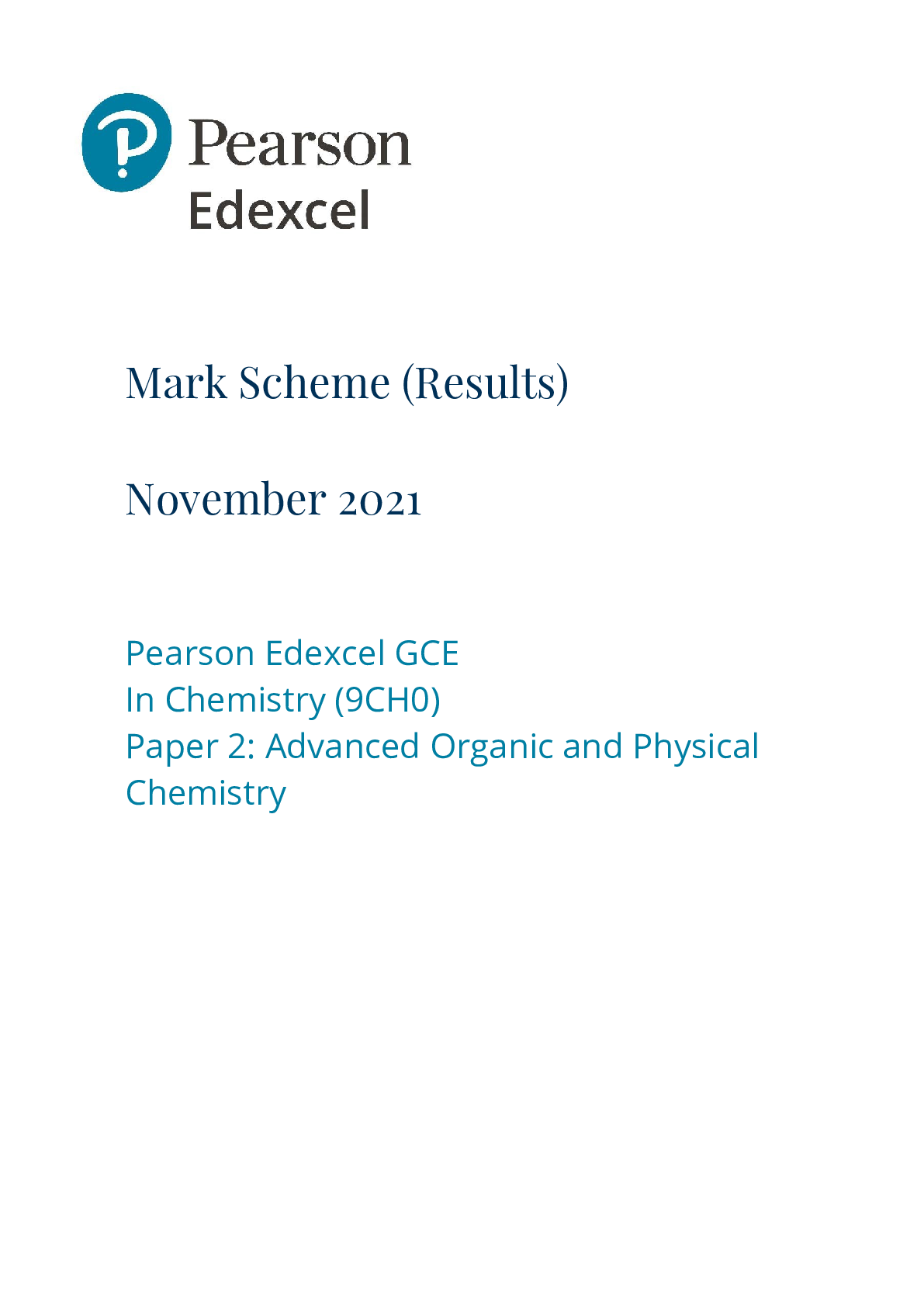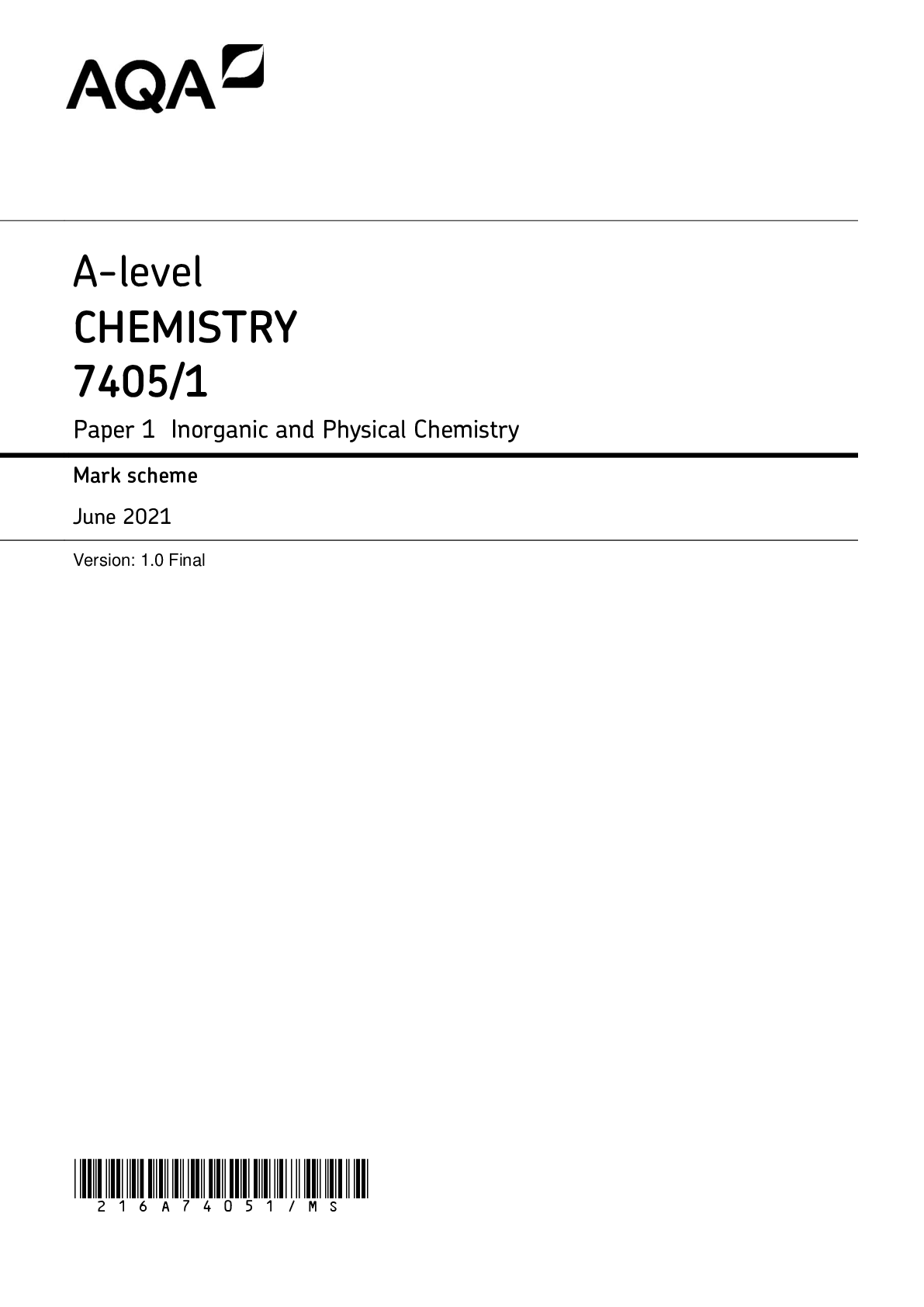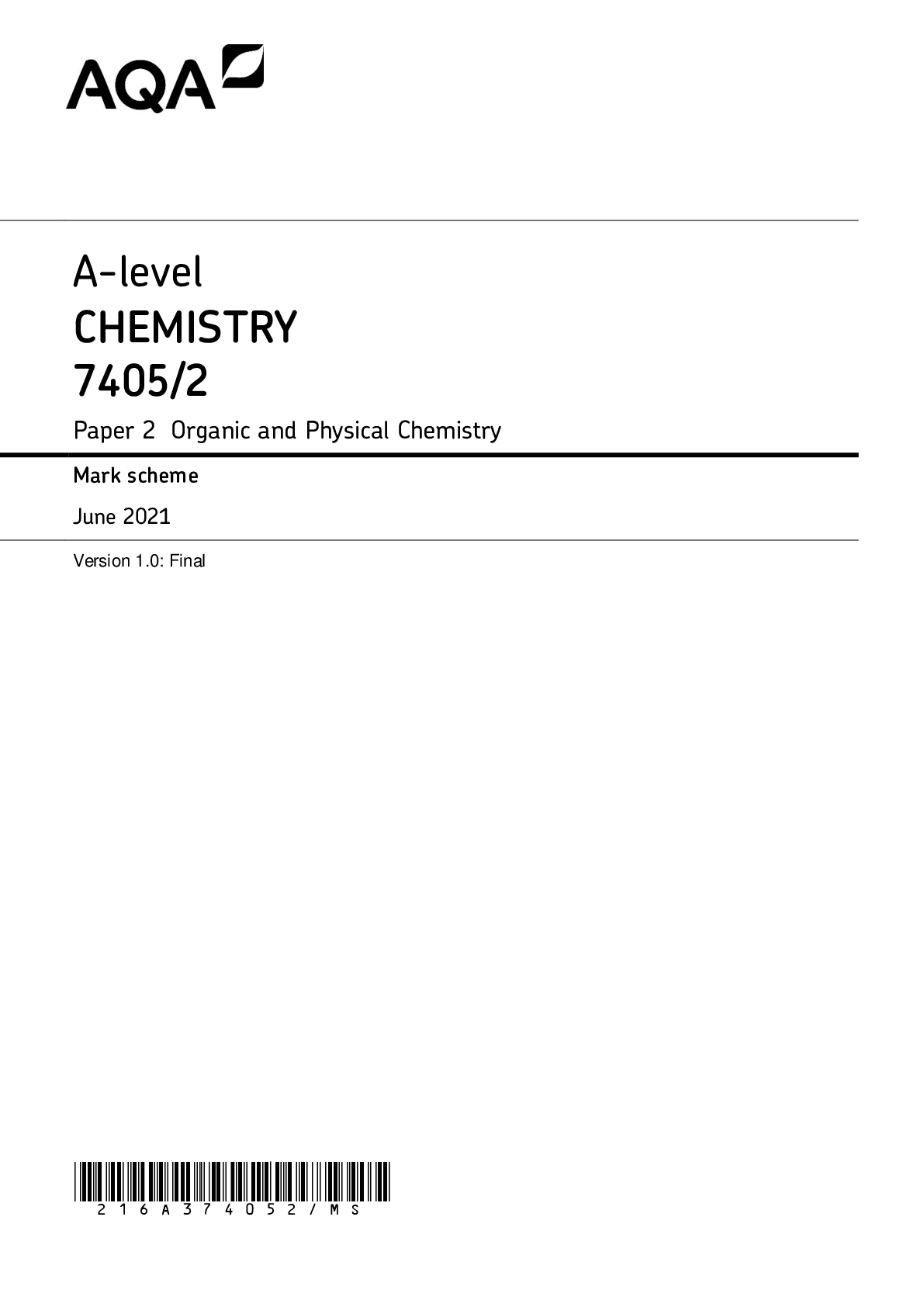Mathematics > MARK SCHEMES > AQA AS CHEMISTRY 7404/1 PAPER 1 INORGANIC AND PHYSICAL CHEMISTRY MARKING SCHEME JUNE 2019 FINALAS Ch (All)
AQA AS CHEMISTRY 7404/1 PAPER 1 INORGANIC AND PHYSICAL CHEMISTRY MARKING SCHEME JUNE 2019 FINALAS Chemistry 7404/1 Inorganic and Physical Chemistry Mark scheme
Document Content and Description Below
AQA AS CHEMISTRY 7404/1 PAPER 1 INORGANIC AND PHYSICAL CHEMISTRY MARKING SCHEME JUNE 2019 FINALAS Chemistry 7404/1 Inorganic and Physical Chemistry Mark scheme 7404 June 2016 Version 1.0: Fina... lCopyright © 2016 AQA and its licensors. All rights reserved. AQA retains the copyright on all its publications. However, registered schools/colleges for AQA are permitted to copy material from this booklet for their own internal use, with the following important exception: AQA cannot give permission to schools/colleges to photocopy any material that is acknowledged to a third party even for internal use within the centre. Mark schemes are prepared by the Lead Assessment Writer and considered, together with the relevant questions, by a panel of subject teachers. This mark scheme includes any amendments made at the standardisation events which all associates participate in and is the scheme which was used by them in this examination. The standardisation process ensures that the mark scheme covers the students’ responses to questions and that every associate understands and applies it in the same correct way. As preparation for standardisation each associate analyses a number of students’ scripts. Alternative answers not already covered by the mark scheme are discussed and legislated for. If, after the standardisation process, associates encounter unusual answers which have not been raised they are required to refer these to the Lead Assessment Writer. It must be stressed that a mark scheme is a working document, in many cases further developed and expanded on the basis of students’ reactions to a particular paper. Assumptions about future mark schemes on the basis of one year’s document should be avoided; whilst the guiding principles of assessment remain constant, details will change, depending on the content of a particular examination paper. Further copies of this mark scheme are available from aqa.org.uk.3 of 17 AS and A-level Chemistry Mark scheme instructions for examiners 1. General The mark scheme for each question shows: • the marks available for each part of the question • the total marks available for the question • the typical answer or answers which are expected • extra information to help the examiner make his or her judgement and help to delineate what is acceptable or not worthy of credit or, in discursive answers, to give an overview of the area in which a mark or marks may be awarded. The extra information in the ‘Comments’ column is aligned to the appropriate answer in the left-hand part of the mark scheme and should only be applied to that item in the mark scheme. You should mark according to the contents of the mark scheme. If you are in any doubt about applying the mark scheme to a particular response, consult with your Team Leader. At the beginning of a part of a question a reminder may be given, for example: where consequential marking needs to be considered in a calculation; or the answer may be on the diagram or at a different place on the script. In general the right-hand side of the mark scheme is there to provide those extra details which confuse the main part of the mark scheme yet may be helpful in ensuring that marking is straightforward and consistent. The use of M1, M2, M3 etc in the right-hand column refers to the marking points in the order in which they appear in the mark scheme. So, M1 refers to the first marking point, M2 the second marking point etc. 2. Emboldening 2.1 In a list of acceptable answers where more than one mark is available ‘any two from’ is used, with the number of marks emboldened. Each of the following bullet points is a potential mark. 2.2 A bold and is used to indicate that both parts of the answer are required to award the mark. 2.3 Alternative answers acceptable for a mark are indicated by the use of OR. Different terms in the mark scheme are shown by a / ; eg allow smooth / free movement.4 of 17 3. Marking points 3.1 Marking of lists This applies to questions requiring a set number of responses, but for which students have provided extra responses. The general principle to be followed in such a situation is that ‘right + wrong = wrong’. Each error / contradiction negates each correct response. So, if the number of error / contradictions equals or exceeds the number of marks available for the question, no marks can be awarded. However, responses considered to be neutral (often prefaced by ‘Ignore’ in the mark scheme) are not penalised. 3.2 Marking procedure for calculations Full marks should be awarded for a correct numerical answer, without any working shown, unless the question states ‘Show your working’ or ‘justify your answer’. If an answer to a calculation is incorrect and working is shown, process mark(s) can usually be gained by correct substitution / working and this is shown in the ‘Comments’ column or by each stage of a longer calculation. 3.3 Extended responses Where a mark scheme includes linkage words (such as ‘therefore’, ‘so’, ‘because’ etc), these are optional. However, a student’s marks for the question may be limited if they do not demonstrate the ability to construct and develop a sustained line of reasoning which is coherent, relevant, substantiated and logically structured. In particular answers in the form of bullet pointed lists may not be awarded full marks if there is no indication of logical flow between each point or if points are in an illogical order. 3.4 Equations In questions requiring students to write equations, state symbols are generally ignored unless otherwise stated in the ‘Comments’ column. Examiners should also credit correct equations using multiples and fractions unless otherwise stated in the ‘Comments’ column. 3.5 Organic structures Where students are asked to draw organic structures, these may be given as displayed, structural or skeletal formulas unless a specific type of structure is required in the question and stated in the mark scheme. 3.6 Interpretation of ‘it’ Answers using the word ‘it’ should be given credit only if it is clear that the ‘it’ refers to the correct subject.5 of 17 3.7 Errors carried forward, consequential marking and arithmetic errors Allowances for errors carried forward are most likely to be restricted to calculation questions and should be shown by the abbreviation ECF or consequential in the marking scheme. An arithmetic error should be penalised for one mark only unless otherwise amplified in the marking scheme. Arithmetic errors may arise from a slip in a calculation or from an incorrect transfer of a numerical value from data given in a question. 3.8 Phonetic spelling The phonetic spelling of correct scientific terminology should be credited unless there is a possible confusion with another technical term or if the question requires correct IUPAC nomenclature. 3.9 Brackets (…..) are used to indicate information which is not essential for the mark to be awarded but is included to help the examiner identify the sense of the answer required. 3.10 Ignore / Insufficient / Do not allow Ignore or insufficient is used when the information given is irrelevant to the question or not enough to gain the marking point. Any further correct amplification could gain the marking point. Do not allow means that this is a wrong answer which, even if the correct answer is given, will still mean that the mark is not awarded. 3.11 Marking crossed out work Crossed out work that has not been replaced should be marked as if it were not crossed out, if possible. Where crossed out work has been replaced, mark the replacement work and not the crossed out work.MARK SCHEME – AS CHEMISTRY – 7404/1 – JUNE 2016 6 of 17 Question Marking Guidance Mark Comments 01.1 1s22s22p63s23p1 1s22s22p63s23p63d3 1 1 If noble gas core used correctly in both then scores 1 Allow subscripts and capitals Ignore 4s0 01.2 Sr2+ 1 Ignore name and correct proton/mass number Allow Sr+2 01.3 Ca3P2 1 Allow reversed or ionic formula Ignore nameMARK SCHEME – AS CHEMISTRY – 7404/1 – JUNE 2016 7 of 17 Question Marking Guidance Mark Comments 02.1 Mg(2+) or Magnesium Because Mg2+ has more protons AND With the same shielding/screening/electron arrangement/number of electrons (or isoelectronic) 1 1 Na+ CE=0 Allow larger/stronger nuclear charge Ignore atomic radius 02.2 Na(g) → Na+(g) + e− 1 1 for correct species and gas phase Allow e without charge Allow Na(g) - e− → Na+(g) Na(g) + e− → Na+(g) + 2e− 02.3 Mg between 600-800 S between 800-1040 e− paired in (3)p orbital in S (owtte) Paired e− repel (so less energy needed to remove) 1 1 1 1 If S not lower than P on graph then M1 only If no plots on graph must state S below P to access M3 & M4 Allow (3)p subshell/sublevel provided pair mentionedMARK SCHEME – AS CHEMISTRY – 7404/1 – JUNE 2016 8 of 17 Question Marking Guidance Mark Comments 03.1 Selects correct titres mean titre = 9.75 + 9.65 2 = 9.7(0) cm3 mol HCL = 0.102 × 9.70/1000 = 9.89x10-4 (allow 9.9x10-4 for M3 but check not via 4 titres in which case only 1 mark) 1 1 1 If 3 or more titres used them MAX 1 for conseq M3 Calculates mean Calculates mol (working or result gains credit) 9.92x10-4 scores 1 if all 4 titres used 9.83x10-4 scores 1 if titres 1,2,and 3 used 03.2 mol MHCO3 = ANS 3.1 x 10 (= 9.89 x 10-3) Mr = 1464/1000 ?1 Mr = 148 (3sf) 1 1 1 Use ecf if wrong mean calculated above Allow ecf following wrong mass conversion 03.3 Suggestion: Use a larger mass of solid OR use a more concentrated solution of MHCO3 OR less concentrated / more dilute solution of HCl OR more MHCO3 Justification: So a larger titre/reading will be needed OR larger volume of HCl 1 1 Cannot score justification mark unless suggestion correct, but suggestion could be after justification Assume reference to the solution means the MHCO3MARK SCHEME – AS CHEMISTRY – 7404/1 – JUNE 2016 9 of 17 Question Marking Guidance Mark Comments 03.4 This question is marked using levels of response. Level 3 - Must use volumetric flask to access level 3 Answer is communicated coherently and shows a logical progression from stage 1 to stage 2 then stage 3. 6 marks - All stages are covered and the description of each stage is complete 5 marks – all stages are covered but up to 2 omissions/errors from different stages. If 2 omissions/errors from same stage only level 2 possible Level 2 Answer is mainly coherent and shows progression from stage 1 to stage 3 4 marks - All stages are covered but 3 omissions/errors 3 marks – all stages are attempted Level 1 Answer includes isolated statements but these are not presented in a logical order or show confused reasoning. 2 marks – 2 stages attempted 1 mark – 1 stage attempted Level 0 0 marks Insufficient correct chemistry to gain a mark. 6 Indicative Chemistry content Stage 1: transfers known mass of solid a) Weigh the sample bottle containing the solid on a (2 dp) balance b) Transfer to beaker* and reweigh sample bottle c) Record the difference in mass Or d) Place beaker* on balance and tare e) Transfer solid into beaker f) Record mass Or g) Known mass provided h) Transfers (known) mass into beaker* i) Wash all remaining solid from sample bottle into beaker Allow use of weighing boat *Allow other suitable glassware including volumetric flask Stage 2: Dissolves in water a) Add distilled / deionised water b) Stir (with a glass rod) or swirl c) Until all solid has dissolved Stage 3: Transfer, washing and agitation a) Transfer to volumetric / graduated flask. Allow if a clear description/diagram given eg long necked flask with 250cm3 mark b) With washings c) Make up to 250cm3 / mark with water d) Shakes/inverts/mixesMARK SCHEME – AS CHEMISTRY – 7404/1 – JUNE 2016 10 of 17 Question Marking Guidance Mark Comments 04.1 Structures M1 Bromine is (simple) molecular / simple molecules M2 Magnesium is metallic / consists of (positive) ions in a (sea) of delocalised electrons Strength M3 Br2 has weak (van der Waals) forces between the molecules / weak IMFs M4 so more energy is needed to overcome the Stronger (metallic) bonds or converse. The comparison could be direct or implied. Liquid range M5 Mg has a much greater liquid range because forces of attraction in liquid / molten metal are strong(er) OR converse argument for Br2 1 1 1 1 1 Chemical Error penalties If Br2 (covalent) bonds broken lose M3 and M4 If eg Mg molecules or Mg ionic bonds lose M2 and M4 Must refer to liquid range to score M5MARK SCHEME – AS CHEMISTRY – 7404/1 – JUNE 2016 11 of 17 Question Marking Guidance Mark Comments 05.1 n = PV/RT 102 000 ×�1.00 × 10−3� 8.31 × 300 = ? = (4.091456077x10-2) Mass = M2 x 17 = 0.696 (g) (3 sig figs only) 1 1 1 If PV=nRT rearranged incorrectly then M3 only Allow 0.695 or 0.697 05.2 If pV = nRT Total volume = ??? ? = ? × 8.31 × 295 75 000 = 1.34 × 10-3 m3 Volume of Q in m3 = 1.00 x 10−3 Volume of bulb P = 1.34 x 10−3 – 1.00 x 10−3 Volume of bulb P = 3.42 x 10−4 m3 = 342 cm3 (Allow 310-342 cm3) 1 1 1 Incorrect unit conversion loses M1 only; can get M2/M3 if possible volume obtained Inserts correct numbers (inc pressure in Pa) No subtraction M1 only Alternative method also worth full credit (note if mol in M2 of 05.1 rounded to 0.04 this could lead to a final answer of 3.1x10-4m3 so allow range 310-342cm3MARK SCHEME – AS CHEMISTRY – 7404/1 – JUNE 2016 12 of 17 Question Marking Guidance Mark Comments 06.1 (Ions accelerated by) attraction to negatively charged plate / electric field Ions detected by gaining electrons Abundance determined by (size) of current flowing (or amount of electrons gained) in the detector 1 1 1 Mark independently Allow the transfer of electrons Allow current is proportional to abundance 06.2 Mass = 52/1000 6.022x1023 Mass = 8.6(4)x10-26 1 06.3 V2 = (2x1.269x10-13)/8.64x10-26 V= 1.71x106ms-1 1 1 Allow correct rearrangement for V or V2 Allow ecf from 6.2 (note if 8.6x10-23 in 6.2 leads to approx. 5.4x104 ms-1) 06.4 Sketch with peaks at 158,160,162 In ratio 25%:50%:25% 1 1 Mark independently Allow approx. ratio 1:2:1MARK SCHEME – AS CHEMISTRY – 7404/1 – JUNE 2016 13 of 17 Question Marking Guidance Mark Comments 06.5 % abundance mXe = 20(%) 131.31=(0.28*129)+(0.25*131)+(0.27*132)+(0.20*m) 131.31-104.51=0.2m Mass number = 134 1 1 1 1 Working must be shown Answer must be an integer [Show More]
Last updated: 2 years ago
Preview 1 out of 18 pages
.png)
Buy this document to get the full access instantly
Instant Download Access after purchase
Buy NowInstant download
We Accept:

Reviews( 0 )
$8.00
Can't find what you want? Try our AI powered Search
Document information
Connected school, study & course
About the document
Uploaded On
Sep 05, 2022
Number of pages
18
Written in
Seller

Reviews Received
Additional information
This document has been written for:
Uploaded
Sep 05, 2022
Downloads
0
Views
117


.png)

.png)











